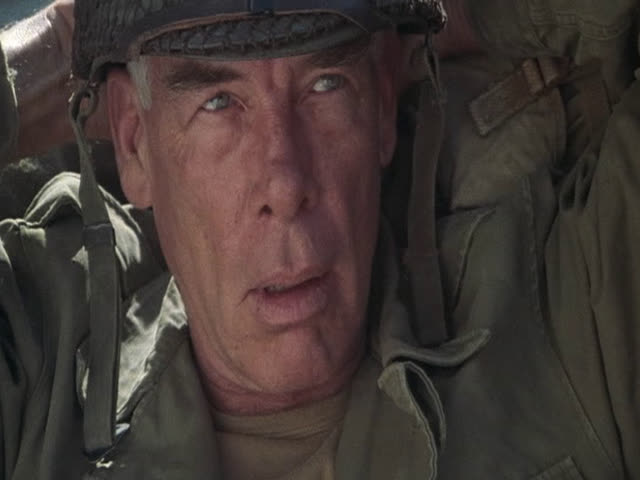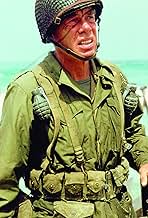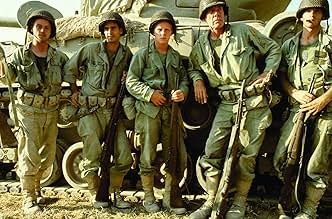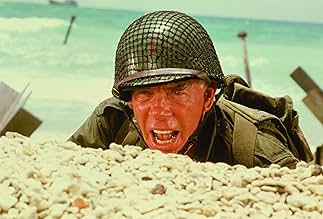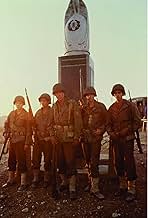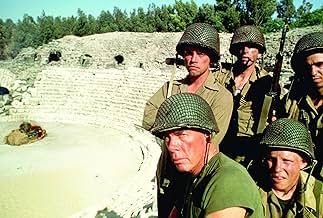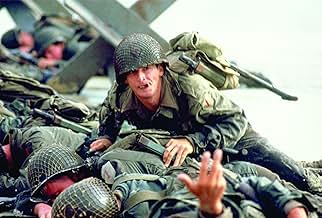Um sargento endurecido e os quatro membros principais de sua unidade de infantaria tentam sobreviver à Segunda Guerra Mundial enquanto se movem de batalha em batalha por toda a Europa.Um sargento endurecido e os quatro membros principais de sua unidade de infantaria tentam sobreviver à Segunda Guerra Mundial enquanto se movem de batalha em batalha por toda a Europa.Um sargento endurecido e os quatro membros principais de sua unidade de infantaria tentam sobreviver à Segunda Guerra Mundial enquanto se movem de batalha em batalha por toda a Europa.
- Prêmios
- 2 vitórias e 2 indicações no total
- Underground Walloon Fighter at Asylum
- (as Stephane Audran)
Avaliações em destaque
The "old" version was very good, and this newer version makes the film even better. Either way, you have a solid war movie.
For men - and that's who will primarily watch this movie because it's a guy's flick with no romance and no women leads - this keeps the action coming, but without overdoing it. You can different kinds of action scenes, too, not just people shooting at one another.
I also appreciated the photography. It's a good visual movie. The added footage looked sharper and clearer than the previously shown, but either way it was nicely filmed and directed. Of course, the director is the famous Sam Fuller, who did a number of tough film noirs, among other things.
Speaking of tough, the person who makes this movie a notch above average is Lee Marvin. He is just excellent as the tough-on-the-outside-but-soft-hearted underneath commanding officer, known only as "The Sergeant." With his deep voice and weathered face, Marvin makes for an effective leader of tough guys. The language was much milder in here than you find in more modern films, although it can be crude in a few spots. There are no f-words and about seven usages of the Lord's name in vain. However, there are a number of sexual references, some crude but, hey, that's "guy talk." All the young soldiers were good, too. It was especially interesting to see baby-faced Star Wars' star, Mark Hamill, playing one of the soldiers in the unit called "The Big Red One."
The story with narration by one of the soldiers, tells of Marvin and his handful of men who travel and do battle from North Africa to Sicily, then Italy, the beaches of Normandy on D- Day and into Germany in addition to a few other memorable stops such as "an insane asylum."
It's long, but I never found it boring and the men never stay too long in one spot.
I cannot agree with these beliefs. The Big Red One is not only one of the greatest WWII films, it is also one of the greatest war movies.
Sam Fuller's film, which was butchered by the studio, is the picaresque tale of 5 members of the First Infantry, known, because of their shoulder patch, as the Big Red One. The film moves from one story to the next without spending too much time on any particular tale.
The individual vignettes, as they must, vary in quality, but on the whole are excellent. The Big Red One stirs within you a desire to run right out and tell your friends about this amazing scene or that.
There's the soldier who loses his testicle, the birthing scene in the belly of a tank, Lee Marvin, in Middle Eastern garb, traipsing across a beach, soldiers dug into holes over which a Panzer tank division travels, the entire Mad House segment... The list goes on.
Some people dislike the absurdest nature of several of this film's stories, but, for me, those surreal touches make this film great.
Without them (and there are a lot), you would be left with a very normal and very boring film. Using bandoleers as stirrups is genius, as is the woman faking crazy as she whirls through a monastery, slicing German throats.
The performances are solid, for this type of film, but if you are looking for subtlety, go elsewhere. Each character is drawn in broad strokes; you never learn too much about them, but you learn enough to understand who they are and why. Lee Marvin, as usual, is amazing. He is one of the great, gruff actors of our time, bringing a special, intangible quality to every film in which I've seen him. He makes every movie he's in better just by showing up. There are too few actors about whom you can say that.
Like the acting, the direction is masculine, but, for a war movie, that's a compliment. In some ways, Fuller's direction here and in his other films reminds me of Hemmingway's writing - terse and effective. Both men believe in an economy of shots or words, depending on their medium, but, through that economy, they attain a muscular sort of poetry akin to the beauty of a horse's rippling muscles as it races on a plain. Fuller's direction here, though not his best when compared to Underworld USA or Shock Corridor, is still better than most, especially considering that this was his first film in several years.
All in all, I find the Big Red One to be an exemplary war movie, even in its emasculated format (I cannot wait to see the restored, 140 minute print, which should improve upon scenes that feel to brief in this version). It's certainly no Apocalypse Now, but it puts to shame most World War II epics before or since.
The premise is simple: the experiences of a US infantry squad led by Lee Marvin fighting in Europe and North Africa during WW II. It was supposed to be about the experiences of the men who fought but I didn't feel the film delivered that: none of the characters were really explored or given much depth, even the great Lee Marvin seemed distant and cold. There isn't too much dialogue, in fact there isn't too much of anything in this film. Its just there but it doesn't really give you much, it just leaves you cold. The plot is occasionally just plain weird and confusing, not the good kind of quirky type of weird but just strange for no apparent reason and with no charm to it.
The action scenes are average, nothing special but enough for their purpose. What annoyed me was that so many different locations were so obviously filmed in the same sandy country (Israel) and it just didn't come off as very convincing. I didn't believe that what I was being shown was really the place it was supposed to be. Its also a quiet film, with very minimal music which in itself isn't bad but just gave the whole thing a somewhat sleepy atmosphere. I wouldn't go so far as to say the film was boring, it wasn't but it just wasn't that attention grabbing either.
Its a film that is there but it did absolutely nothing for me. Others however might enjoy it.
All of the characters are very likeable, and well acted by Lee Marvin, Mark Hamill, Robert Carradine, and company. The movie is fiction but influenced by real events. Many of the scenes, especially one involving a group of older sicilian women who cook a big meal for the squad, ring very true, since a fiction writer would obviously try and spice them up--the film is very honest, and it is good that Fuller left this story for us. I also like how it ends on a positive, optimistic note.
"The real glory of war is surviving."
Maybe the movie is too overlong which reduces its impact but it's extremely rewarding to see this one.
I give this a 7 (seven).
Você sabia?
- CuriosidadesThe bulk of the picture was shot in Israel, and director Samuel Fuller remarked that it was unsettling after a scene was shot when the German soldiers and SS troops would take off their helmets and Fuller would see them wearing yarmulkes; also, between takes they would be sitting around the set in full Nazi uniform speaking Hebrew or reading the Torah.
- Erros de gravaçãoDuring the WW1 scene between the Sergeant and the officer in the dug-out, the Sergeant learns that the armistice had been signed 4 hours previously at 1100hrs, November 11, 1918. While talking with the officer, the sergeant is cutting a piece of red cloth in the shape of a number '1' which he says he will submit as a proposed insignia for the division. However the shoulder sleeve insignia for the 1st Division consisting of a red number "1" was already approved on 31 Oct 1918.
- Citações
[the troop stops before a memorial]
Johnson: Would you look at how fast they put the names of all our guys who got killed?
The Sergeant: That's a World War One memorial.
Johnson: But the name's are the same.
The Sergeant: They always are.
- Versões alternativasIn 2004, film critic Richard Schickel restored this film to a new director's cut length of approximately 160 minutes. Using Samuel Fuller's production notes and the full-length, unexpurgated script, Schickel restored the footage that was forced to be cut by the studio upon its original 1980 release (which runs 116 minutes). The restored version's DVD release date is 3 May 2005. This longer, epic-length version is closer to Fuller's original vision for the film.
- ConexõesFeatured in A tout coeur: Episode dated 7 May 1984 (1984)
- Trilhas sonorasHorst-Wessel-Lied
Written by Horst Wessel
Principais escolhas
Detalhes
- Data de lançamento
- País de origem
- Idiomas
- Também conhecido como
- Más allá de la gloria
- Locações de filme
- Empresas de produção
- Consulte mais créditos da empresa na IMDbPro
Bilheteria
- Orçamento
- US$ 4.500.000 (estimativa)
- Faturamento bruto nos EUA e Canadá
- US$ 7.206.220
- Faturamento bruto mundial
- US$ 7.206.823
- Tempo de duração1 hora 53 minutos
- Cor
- Mixagem de som
- Dolby Stereo(original release)
- Proporção
- 1.85 : 1
Contribua para esta página


